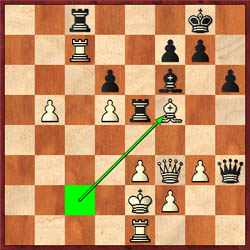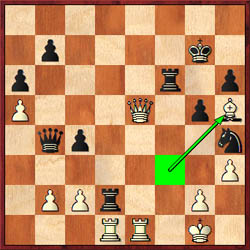 |
 |
 |
 |
 |
 |
 |
 |
 |
 |
 |
 |
|
|
|
|
|
|
|
|
|
|
|
|
|
|
 |
|
|
.jpg)
|
|
|
|
|
|
|

|
|
|
|
|
|
|
|
|
|
|
|
|
Round #4 Pairings
Topolov (Bulgaria) - Adams (England)
Kasimdzhanov (Uzbekistan) - Anand (India)
Leko (Hungary) - Polgar (Hungary)
Morozevich (Russia) - Svidler (Russia)
***
Round #4 Results
Topalov-Adams, 1-0. Chess.FM commentators GMs Varuzhan Akopian and John Fedorowicz were amazed at the performance of Veselin Topalov. During the game, they had problems figuring out exactly what Bulgarian GM was doing. In the end, they referred to his performance as "amazing" and "unbelievable." Certainly Topalov's performance will be viewed as one of the most energetic performances in the tournament.
Topalov proved why he is such a hard player to prepare as he trotted out 1.Nf3 and headed for an English. Immediately, Topalov began to make strange moves to create an imbalance such as 10.Bf1!? and 11.h4 (apparently to play Ng5). What a strange formation! The move 13.a4!? really caused befuddlement as both commentators advocated 13.Ng5 Bxg5 14.hxg5 with the idea of f3, e4 and possibly using the open h-file after Kg2 and Rh1. Topalov later revealed his a2-a4 plan after 16.Ra3!? His "loosed" rook would play a key role in grabbing his advantage.
|
|
|
|
|
|
|
|
|
|
|
|
|
|
Perhaps the key moment came when Adams played 16…b5 seeking counterplay. This was identified later as a crucial mistake. After 16.axb5 Nb6 17.c4! 17…Bxf3 18.Rxf3! Nxc4 19.Qa4 Ne5 20.Ra3 Re8 21.h5! white had a huge space advantage. Topalov then set up a battery on the b1-h7 diagonal with Be4-c2 and Qa4-e4.
The pace quickened in the game as Adams spent the next 15 moves seeking counterplay with tactical resources. However, he had difficulties dealing with back rank threats. Adams tried activating by 35…Rc8, but was victim of the shocking 36.Bf5! which received cheers from the ICC (diagram). Akopian exclaimed, "Beautiful! Beautiful!" The game ended after 36…Rxf5 37.Rxc8+ Kh7 38.Rh1! (game)
|
|
|
|
|
|
|
|
|

|
|
|
|
|
|
|
|
|
|
|
|
|
Kasimjanov-Anand, 1-0. Kasimjanov made believers out of chess fans around the world by vanquishing the pre-tournament favorite in fine fashion. Many have been debating Kasimjanov's legitimacy as a competitor in this field by emphasizing his prowess only at "rapid" chess, but he certainly reached a 2701 rating (October 2001) by playing classical chess.
|
|
|
|
|
|
|
|
|
|
|
|
|
|
In this game, we saw yet another Najdorf, but this time the tricky 6.Be3 Ng4 variation. Fedorowicz has stated that this line for black has been suffering since the prophylactic 10.h3. Anand gave up his light-squared bishop and his kingside weaknesses were soon glaring after 22.Qg4. Anand sought counterplay, but Kasimjanov remained solid and kept pressuring the light squares. Anand lashed out with 26…Rxf2!? Interesting! Chess.FM commentators where considering 27.Bf3 Qc5, but clearly 28.Rd5 is to order, so Anand went in for 27…Rd2. The light-square weaknesses were realized after 33.Bh5! a move that is Kasimjanov's found in time pressure. The fruits of his labor paid off as the ensuing sequence ended in a mating attack. (game)
|
|
|
|
|
|
|
|
|

|
|
|
|
|
|
|
|
|
|
|
|
|
Leko-Polgar, 1-0. Two Hungarians battle under different conditions. Leko was having a slow start and Polgar was coming off a nice win against Kasimjanov. Leko was in a "must-win" situation here. One cannot afford to go -3 in such an event. Nevertheless, it would be a serious battle.
Polgar rolled out the Taimanov, a defense used in drawing with Adams… but just barely! She tried the solid 7… Nc6 line against Leko instead of committal 7…b5 employed against Adams. However, according to her sister Susan Polgar, "On move 12, Judit made the first of many inaccuracies. A better option would have been 12...d5." Judit had played 12…Ng6 which drew consternation from practically everyone watching the game. What purpose could this move serve when facing a potential avalanche of pawns?
Polgar attempted to conjure tactical threats on f4 and c3 and Leko did miss opportunities to play f5, but appeared to get a decisive advantage with 21.Nb5! Rxb5 22.Rxb5 axb5 23.Qxb4. After the wayward b8-c6-e7-g6-h5 knight find earned its pay with 23…Nhxf4, Leko solidified with 24.Nc3 Rxh2 and 25.Bg1. Here Judit Polgar resigned, but her sister states, "I am not sure why my sister resigned on move 25. I agree that her final position was very bad but it was far from resignable. I would have certainly played on." Certainly, Judit Polgar will look to make opening adjustments for future rounds. (game)
|
|
|
|
|
|
|
|
|
|
.jpg)
|
|
|
|
|
|
|
|
|
|
|
|
|
|
|
|
Morozevich-Svidler, 0-1. This would be the strangest game in the round. Morozevich had built a comfortable advantage in space against the King's Indian and according to the Chess. FM commentators, should have pressed harder. Perhaps instead of sacrificing a pawn to invade the 7th rank with 31.Nd5, the move 31.Qg4 may have maintained more attacking options. Morozevich's advantage slowly frittered away.
After 35.Qa7+, it was clear that Svidler had a bead on the vulnerable kingside pawns while his active pieces danced throughout the board. With full initiative, Svidler ate the two weakened pawns as Morozevich tried in vain to advance his pawns up the board. In what was perhaps the most demoralizing loss thus far, Morozevich ended the game facing mate. (game)
Standings:
1st Topalov, 3½-½
2nd Svidler, 3-1
3rd Anand, 2½-1½
4th Kasimjanov, 2-2
5th-6th Leko, Polgar, 1½-2½
7th-8th Adams, Morozevich, 1-3
The Chess Drum, "2005 FIDE WCC: Topalov on Top!!," 3 October 2005.
|
|
|
|
|
|
|
|
|
|

|
|
|
|
|
|
|
|
|
|
|
 |
|



.jpg)
